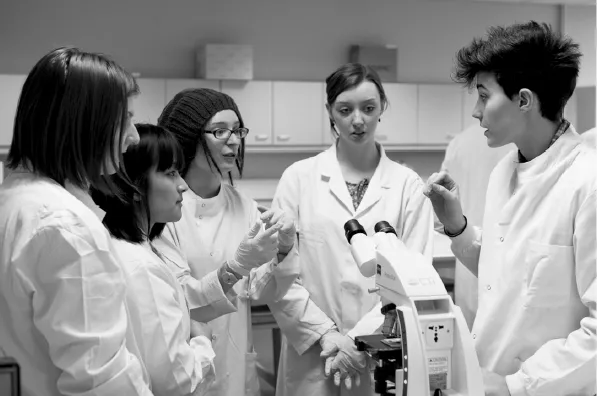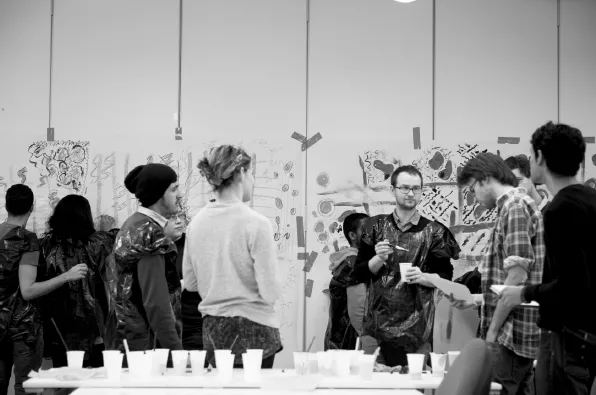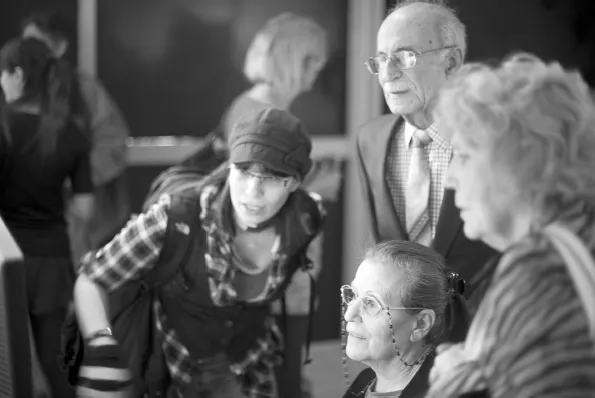
eBook - ePub
For the Love of Learning
Innovations from Outstanding University Teachers
Tim Bilham
This is a test
Share book
- 312 pages
- English
- ePUB (mobile friendly)
- Available on iOS & Android
eBook - ePub
For the Love of Learning
Innovations from Outstanding University Teachers
Tim Bilham
Book details
Book preview
Table of contents
Citations
About This Book
Edited collection featuring essays from exceptional National Teaching Fellows. Presents the cutting-edge of pedagogical thinking on the most important topics in higher education today, including student engagement, assessment, internationalisation and employability. Destined to become a 'must-read' guide for anyone involved in higher education.
Frequently asked questions
How do I cancel my subscription?
Can/how do I download books?
At the moment all of our mobile-responsive ePub books are available to download via the app. Most of our PDFs are also available to download and we're working on making the final remaining ones downloadable now. Learn more here.
What is the difference between the pricing plans?
Both plans give you full access to the library and all of Perlego’s features. The only differences are the price and subscription period: With the annual plan you’ll save around 30% compared to 12 months on the monthly plan.
What is Perlego?
We are an online textbook subscription service, where you can get access to an entire online library for less than the price of a single book per month. With over 1 million books across 1000+ topics, we’ve got you covered! Learn more here.
Do you support text-to-speech?
Look out for the read-aloud symbol on your next book to see if you can listen to it. The read-aloud tool reads text aloud for you, highlighting the text as it is being read. You can pause it, speed it up and slow it down. Learn more here.
Is For the Love of Learning an online PDF/ePUB?
Yes, you can access For the Love of Learning by Tim Bilham in PDF and/or ePUB format, as well as other popular books in Éducation & Études supérieures. We have over one million books available in our catalogue for you to explore.
Information
PART 1
Crossing boundaries
Disciplines
Transitions
1 The liquidity of knowledge: learning across disciplinary divides
Heather Barnett (NTF 2012)
Keywords: art/science collaboration, staff/student partnership, knowledge exchange, community of practice, emergent learning, complexity theory, interdisciplinary learning
Heather Barnett is a visual artist, researcher and educator working with biological systems and scientific processes. With interests ranging across medicine, psychology, perception and visualisation, her projects have included microbial portraiture, cellular wallpapers, performing cuttlefish and self-organising installations. She is Senior Lecturer in Photographic Arts at the University of Westminster, London, where she leads the Broad Vision project.
Broad Vision is an art/science research and learning project, which brings together undergraduate students and academic staff from diverse disciplines to engage in collaborative exchange and experimentation. Through interdisciplinary exploration students become teachers, researchers and producers as they engage with questions relating to biology and psychology, technology and creativity, art and science.
Drawing on my observations as Broad Vision project lead and the experiences of collaborating students and staff, this essay will frame the project in relation to interdisciplinary learning, academic hierarchies and emergent curricula – all of which are fluid and mutable.

The Broad Vision project is an educational research project ‘in action’, supported by an interdisciplinary pedagogic research fund at the University of Westminster, London. Since 2010, it has developed learning opportunities across the arts and sciences, with students taking a central role in the design and delivery of an emergent curriculum. Its initial aims were to explore student (and staff) exchange across the disciplines, encourage cross-fertilisation of knowledge and observe outcomes. Motivated by my own experience as an interdisciplinary artist and the desire of colleagues to build relationships within the institution, it is our aim that students ‘realise the value of their preexisting knowledge; gain valuable insights from others; and develop an understanding of the value of interdisciplinary practice’.1 In the project’s lifetime, a phased interdisciplinary educational model has been developed, tested and refined; numerous public outputs have been produced in the form of exhibitions, publications and conference presentations; and an art/science collaboration module accredited, taking the project from an extracurricular programme to an assessed part of the curriculum.2 To date, three generations of students and staff have participated in the project, many continuing their involvement in subsequent years, some even after graduation.

Figure 1.1 Informal learning and sharing of expertise – a Life Sciences student explains what is being viewed down the microscope (in this case, a histology slide of healthy and unhealthy liver tissue) © Chiara Ceolin
The overarching theme of the project has centred on vision and perception: examining how we see, capture and interpret the world around us. Each year a set of images or a body of knowledge has provided a catalyst for student inquiry. For example, in the first year microscopy was employed to explore worlds beyond human vision, in the second a collection of contemporary scientific images prompted discussion,3 and in the third, the theme of ‘data, truth and beauty’ provided stimulus for collaborative projects.

Figure 1.2 A Photographic Arts student instructs a scientist how to use a large-format plate camera in the photography studio © Chiara Ceolin
For each cycle, a group of students volunteer to participate in the project, recruited from courses in psychology, life sciences, imaging science, photographic arts, illustration and contemporary media practice. Interests vary, from scientists in need of a creative output, to artists inspired by scientific subjects and materials: all are curious to step out of their disciplinary comfort zone and experience new subjects and approaches. Whilst motives may differ between the sciences and the arts, both are deeply concerned with inquiry, exploration and the communication of concepts. Through a clearly defined structure of inter/disciplinary learning students are encouraged to ‘differentiate’, between their values, methods and mental processes: and to ‘connect’, identifying possibilities for collaborative working. The ultimate aim is that students should be able to move from mono-disciplinary thinking to the cognitive processes of a more complex interdisciplinary mind.

The Broad Vision project structure is formed of three distinct phases:



Through these phases, students take on the multiple roles of teacher, researcher and producer, as they engage in research, exchange and dissemination. Whilst detailed descriptions can be found in the two Broad Vision publications (Barnett and Smith, 2011; Barnett, 2012), learning activities are broadly designed to shift the roles of students (and tutors) between the positions of expert and novice. The short taster sessions delivered by students in the early phase of the project introduce some aspect of each discipline to the whole group. Moving from laboratory to studio, from classroom to darkroom, activities range from blood-grouping exercises to collective drawing, from photographic portraiture to observing tissue samples down a microscope (Figures 1.1–1.4). The movement between familiar and novel learning environments, combined with the varied roles undertaken and the focus on experiential learning, encourages multiple encounters between participants, where the individual can expand their possibilities through numerous interactions within the collective, turning a ‘private solid state into a liquid network’ (Johnson, 2010: 62). Materials and methods vary, as do intentions and approaches, creating a constant flow of knowledge, experience and interpretation.

Figure 1.3 A Life Sciences student leading a blood-grouping exercise with staff from different disciplines © Chiara Ceolin

Figure 1.4 An Illustration student leading a group drawing exercise, following verbal descriptions and observing the range of interpretations © Chiara Ceolin
The philosophy of the project places students at the forefront of curriculum design. Borrowing from theories of social constructivism (Vygotsky, 1978), the focus is on ‘the processes by which learners build their own mental structures when interacting with an environment [through] self-directed activities orientated towards design and discovery’ (Wenger, 1998a: 279). Through staff/student partnership the learning design creates ‘a holding environment in which both staff and students can safely grow and develop, while challenging each other along the way’ (Little, 2011: 9). Starting with a central theme or a set of images, ideas emerge and curriculum content responds to students’ interest and questions.

Figure 1.5 A student explaining work to visitors to a Broad Vision exhibition at London Gallery West © Chiara Ceolin
All partners, lecturers and students alike, are involved in structuring knowledge within a ‘community of practice’ (Wenger, 1998a), and are able to contribute expertise. This framework, where ‘emphasis is placed on the relationship between elements, rather than the elements themselves’ (Mason, 2008: 21), relates to complexity theory, where ‘what emerges will depend upon what interacts, which is at least partly determined by chance encounters and changes in environments’ (ibid.: 9). In Broad Vision, the emergent projects often lead to outcomes reaching far beyond predictable or predefined intentions, for example; artworks are produced using scientific tools, psychology experiments are run in a gallery, science communication is performed, diagnostic images are presented as art (Figure 1.5).
Here, students become ‘agents’ within a system, operating as individuals within a collective ‘learning super-organism’. All emergent systems – ant colonies, cities and internet networks alike – operate on a basis of random local interactions, a process of constant feedback, a capacity for pattern recognition, and, above all, they operate without direct control (Johnson, 2001). The principles of emergence at play within the Broad Vision structure encourage a fluid exchange of knowledge across the domains and provide continuous feedback, leading to the recognition of patterns (similarities and differences) through a non-hierarchical structure of control. All outcomes from the project emerge from chance encounters and unforeseen points of connection between collaborating individuals, showing that ‘Relationships in these systems are mutual, you influence your neighbours, and your neighbours influence you. All emergent systems are built out of this kind of feedback, the two-way connections that foster high-level learning’ (ibid.: 120). It is this equation, of low-level rules leading to higher-level learning, that the project has aimed to achieve.

As the project has evolved, through three generations of students and staff, data have been captured via written observations, focus discussion groups and exit questionnaires. For myself as project lead, and for our embedded educational researcher, Dr Silke Lange, the material gathered offers insight into how students and staff experience the complexity of this emergent project, and helps us to understand the perceived benefits and challenges related to interdisciplinary learning. In the anonymous exit questionnaires, students identified strongly with the early phase of disciplinary exchange, commenting:
‘It opened up my mind to the different subjects and how they work and think about things.’
Others recognised significance in the role of teacher undertaken, stating:
‘It’s really valuable to have the opportunity to try and teach others what you’ve been taught, helps to condense and revise.’
‘One of the most important parts of the project for me was the ability to show people what I do in my course and how differently I think about them.’
When it came ...